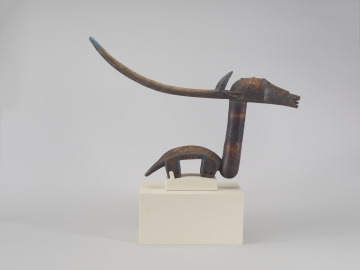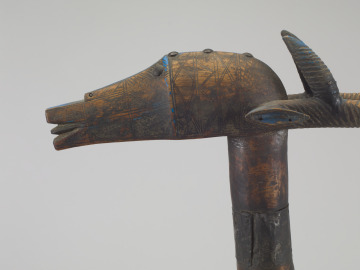Crest Mask (ci-wara kun)
- Artist Culture
- Bamana artist
- Date
- early 20th century
- Material
- Wood, pigment, metal tacks
- possibly associated with
- Koulikoro region, Western Africa and the Guinea Coast, Mali, Africa
Bamako district, Western Africa and the Guinea Coast, Mali, Africa
Kayes region, Western Africa and the Guinea Coast, Mali, Africa - Classification
- Costume & clothing, masks
- Current Location
- On View, Gallery 102
- Dimensions
- 17 1/2 x 25 x 3 3/4 in. (44.5 x 63.5 x 9.5 cm)
- Credit Line
- Museum Shop Fund
- Rights
- Contact Us
- Object Number
- 68:1998
NOTES
This headdress, called "ci-wara kun," primarily represents an antelope, an important animal in Bamana culture. The antelope’s power is a metaphor for the successful farmer who tirelessly tills his fields. Worn on the heads of male dancers, these headdresses are always performed in pairs—one male and one female—to symbolize the fertility of both land and animals. A male mask such as this would have been joined by a female mask and danced together to the sound of drums in order to bring forth the rain, clear the fields, and harvest the crops. Music and entertainment by the masked performers would inspire the young men to work efficiently and in harmony.
Provenance
- 1971
John J. Klejman, New York, NY, USA
1971 -
Balene McCormick, Santa Fe, NM
- 1998
Alexander Gallery, Inc., St. Louis, MO
1998 -
Saint Louis Art Museum, purchased from Alexander Gallery, Inc. [1]
Notes:
[1] An undated invoice [paid by the Museum on December 22, 1998] from Alexander Gallery, Inc. to the Saint Louis Art Museum documents the purchase of this object, listed as "8668 Bamana 'Chi-Wara' Mali, wood, metal, traces blue paint...Ex.Coll. J. [John] J. Klejman 1971 sold / Balene McCormick / Santa Fe, NM 1971" [SLAM document files]. Minutes of the Collections Committee of the Board of Trustees, Saint Louis Art Museum, December 11, 1998.
John J. Klejman, New York, NY, USA
1971 -
Balene McCormick, Santa Fe, NM
- 1998
Alexander Gallery, Inc., St. Louis, MO
1998 -
Saint Louis Art Museum, purchased from Alexander Gallery, Inc. [1]
Notes:
[1] An undated invoice [paid by the Museum on December 22, 1998] from Alexander Gallery, Inc. to the Saint Louis Art Museum documents the purchase of this object, listed as "8668 Bamana 'Chi-Wara' Mali, wood, metal, traces blue paint...Ex.Coll. J. [John] J. Klejman 1971 sold / Balene McCormick / Santa Fe, NM 1971" [SLAM document files]. Minutes of the Collections Committee of the Board of Trustees, Saint Louis Art Museum, December 11, 1998.








